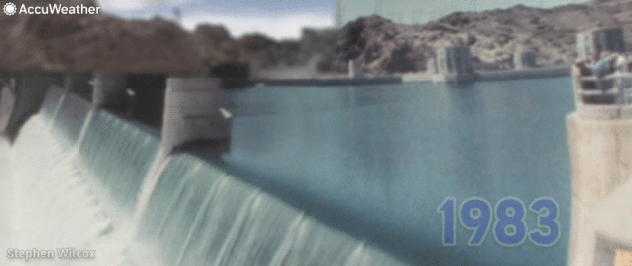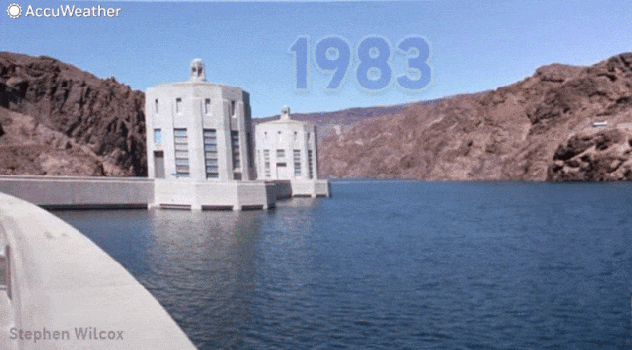Dramatic images show water disappearing from Lake Mead
Bathtub rings lay exposed like ribs of the emaciated Lake Mead, a small snapshot of how climate change and a persisting drought have taken their toll on the Colorado River. With water levels continuing to drop at the Hoover Dam, the federal government declared the first water shortage at Lake Mead on Monday, Aug. 16.
Stephen Wilcox remembers a time when water levels weren't only plentiful but overflowing.
"The sound was thunderous. Water crashing over the edge," Stephen Wilcox reminisced to AccuWeather National Reporter Tony Laubach.
It was the summer of 1983 when Wilcox and his family packed up to visit the dam.
CLICK HERE FOR THE FREE ACCUWEATHER APP
"The lake was so full that the water was going over the spillway, which was a historical event. I thought, 'Well, I want to see this,'" he said.
That year, the lake had reached its highest recorded water level at 1,225 feet. While the maximum lake storage capacity is technically at an elevation of 1,221.4 feet, according to the National Park Service, that elevation reaches the top of the spillway crest at Hoover Dam. The high water line mark is at 1,229 feet.
That summer, water had gushed over the spillway, spewing up mist that "was almost like rain," Wilcox recalled.
Farther upstream, Powell Lake and Glen Canyon Dam were having a similar problem in 1983.
According to a 1995 post from the Los Angeles Times, Lake Powell had been prepared to receive the normal runoff from the snowpack that had been forecast that year. However, warm weather and rain altered that runoff total, and the actual runoff was instead 210% of normal.
 |
A comparison of Lake Mead's 1983 level to 2018 at Hoover Dam (Stephen Wilcox/Google) |
The 1982 to 1983 El Niño Event had been one of the game-changers. From July 1982 to June 1983, both California and Nevada saw the wettest 12-month span to date, according to AccuWeather Senior Meteorologist Bob Smerbeck. The El Niño that season had been one of the strongest on record.
Rivers swelled and dams spilled over until the water reached the Glen Canyon Dam, where 2,000 tons of water per second gushed from the spillways. Four-foot-high sheets of plywood -- soon to be replaced by eight-foot steel plates -- were added to the gates.
 |
But now there is only a meek trickle.
As of Aug. 17, the water level at Lake Mead is at only 1,067.73 feet -- 161.27 feet below the high water line of 1,229 feet. At this same time during 2020, the water level was at 1,084.01 feet.
Back in June, the water level had dropped to the then-record-breaking 1,071.56 feet above sea level. Compared to where water levels had been during 2000, they had fallen by roughly 140 feet, which is nearly the height of the Statue of Liberty.
The reservoir will be considered an "inactive pool" at 1,050 feet and a "dead pool" at 895 feet in elevation, lining up with the lowest water outlet at Hoover Dam.
 |
Unaware that water levels would dip to the extreme that they have, Wilcox recorded the surging water on super 8 movie film.
"What we see in that video is almost a fantasy of water there at the Hoover Dam," Wilcox said.
He called the dropping water levels "yet another sign of the times." While he added that it was worrisome, Wilcox told Laubach that he hopes technology and new ideas will help overcome the challenges ahead.
"I think the best thing to do is to look forward and try to determine how we're going to live with a changing world."
Reporting by Tony Laubach and Bill Wadell.
Keep checking back on AccuWeather.com and stay tuned to the AccuWeather Network on DirecTV, Frontier, Spectrum, FuboTV, Philo, and Verizon Fios.




